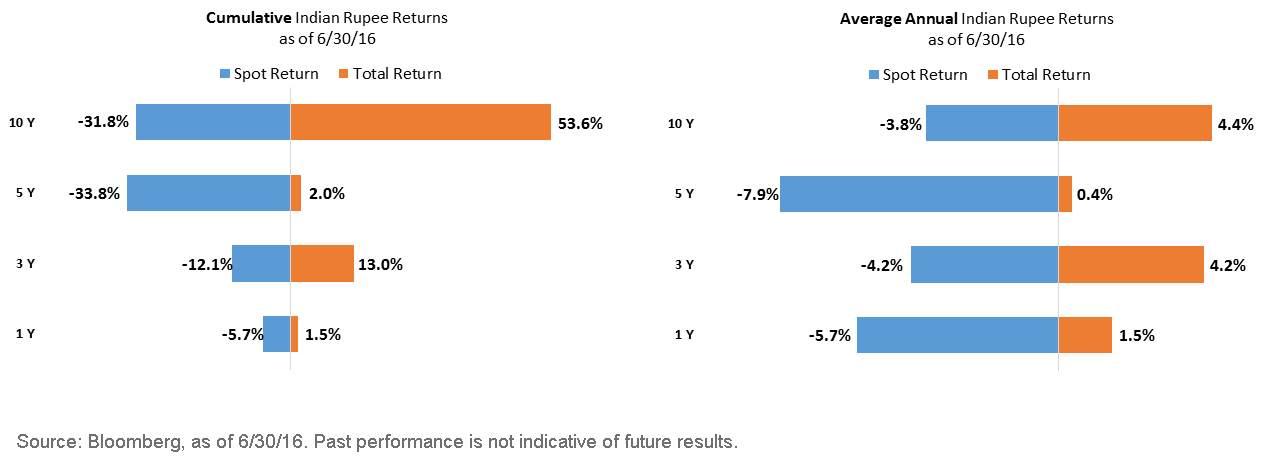Does Currency Hedging Make Sense for India?


 WisdomTree argues that strategic investors may rather have the potential to collect the higher interest rate in India’s local markets. That is why we created the WisdomTree Indian Rupee Strategy Fund (ICN), which seeks to benefit from high short-term interest rates available to investors in India.
This Fund goes long Indian rupee nondeliverable forward contracts to collect the interest rate premium, instead of paying it, as an investor would need to do to hedge the exposure. The forward contracts in the Fund are also collateralized by U.S. cash investments. The combination of interest from the U.S. cash instruments with the interest rate premium approximates the local money market rates in India, which is how the strategy seeks to accomplish its objective.
While there certainly would have been a volatility reduction for investing in India while hedging the rupee, the returns would have been lower over the last 1, 3, 5 and 10 years, all periods when the rupee depreciated.
Many emerging market (EM) currencies offer the potential for excess returns through a couple of factors. First is the convergence to long-term purchasing power. EM currencies are often valued at a discount compared to their long-term purchasing power. As these countries develop, the discount gradually fades as their productivity outstrips productivity in more mature economies. Second, as we discussed, these countries have higher interest rates or carry that attracts capital inflows. In addition, higher carry compensates investors for greater uncertainty in inflation expectations as well as the volatility of spot movements.
For these reasons, we still see the cost to hedge the rupee as an impediment to the long-term returns from rupee-hedging Indian equities.
Unless otherwise noted data source is Bloomberg, as of June 30, 2016.
WisdomTree argues that strategic investors may rather have the potential to collect the higher interest rate in India’s local markets. That is why we created the WisdomTree Indian Rupee Strategy Fund (ICN), which seeks to benefit from high short-term interest rates available to investors in India.
This Fund goes long Indian rupee nondeliverable forward contracts to collect the interest rate premium, instead of paying it, as an investor would need to do to hedge the exposure. The forward contracts in the Fund are also collateralized by U.S. cash investments. The combination of interest from the U.S. cash instruments with the interest rate premium approximates the local money market rates in India, which is how the strategy seeks to accomplish its objective.
While there certainly would have been a volatility reduction for investing in India while hedging the rupee, the returns would have been lower over the last 1, 3, 5 and 10 years, all periods when the rupee depreciated.
Many emerging market (EM) currencies offer the potential for excess returns through a couple of factors. First is the convergence to long-term purchasing power. EM currencies are often valued at a discount compared to their long-term purchasing power. As these countries develop, the discount gradually fades as their productivity outstrips productivity in more mature economies. Second, as we discussed, these countries have higher interest rates or carry that attracts capital inflows. In addition, higher carry compensates investors for greater uncertainty in inflation expectations as well as the volatility of spot movements.
For these reasons, we still see the cost to hedge the rupee as an impediment to the long-term returns from rupee-hedging Indian equities.
Unless otherwise noted data source is Bloomberg, as of June 30, 2016.
Important Risks Related to this Article
There are risks associated with investing, including possible loss of principal. Foreign investing involves special risks, such as risk of loss from currency fluctuation or political or economic uncertainty. This Fund focuses its investments in India, thereby increasing the impact of events and developments associated with the region, which can adversely affect performance. Investments in emerging or frontier markets are generally less liquid and less efficient than investments in developed markets and are subject to additional risks, such as risks of adverse governmental regulation and intervention or political developments. Investments in currency involve additional special risks, such as credit risk and interest rate fluctuations. Derivative investments can be volatile, and these investments may be less liquid than other securities, and more sensitive to the effects of varied economic conditions. As this Fund can have a high concentration in some issuers, the Fund can be adversely impacted by changes affecting those issuers. Unlike typical exchange-traded funds, there are no indexes that the Fund attempts to track or replicate. Thus, the ability of the Fund to achieve its objectives will depend on the effectiveness of the portfolio manager. Due to the investment strategy of this Fund, it may make higher capital gain distributions than other ETFs. Please read the Fund’s prospectus for specific details regarding the Fund’s risk profile. Investments focused in Europe and Japan may increase the impact of events and developments associated with those regions, which can adversely affect performance.

Jeremy Schwartz has served as our Global Chief Investment Officer since November 2021 and leads WisdomTree’s investment strategy team in the construction of WisdomTree’s equity Indexes, quantitative active strategies and multi-asset Model Portfolios. Jeremy joined WisdomTree in May 2005 as a Senior Analyst, adding Deputy Director of Research to his responsibilities in February 2007. He served as Director of Research from October 2008 to October 2018 and as Global Head of Research from November 2018 to November 2021. Before joining WisdomTree, he was a head research assistant for Professor Jeremy Siegel and, in 2022, became his co-author on the sixth edition of the book Stocks for the Long Run. Jeremy is also co-author of the Financial Analysts Journal paper “What Happened to the Original Stocks in the S&P 500?” He received his B.S. in economics from The Wharton School of the University of Pennsylvania and hosts the Wharton Business Radio program Behind the Markets on SiriusXM 132. Jeremy is a member of the CFA Society of Philadelphia.

